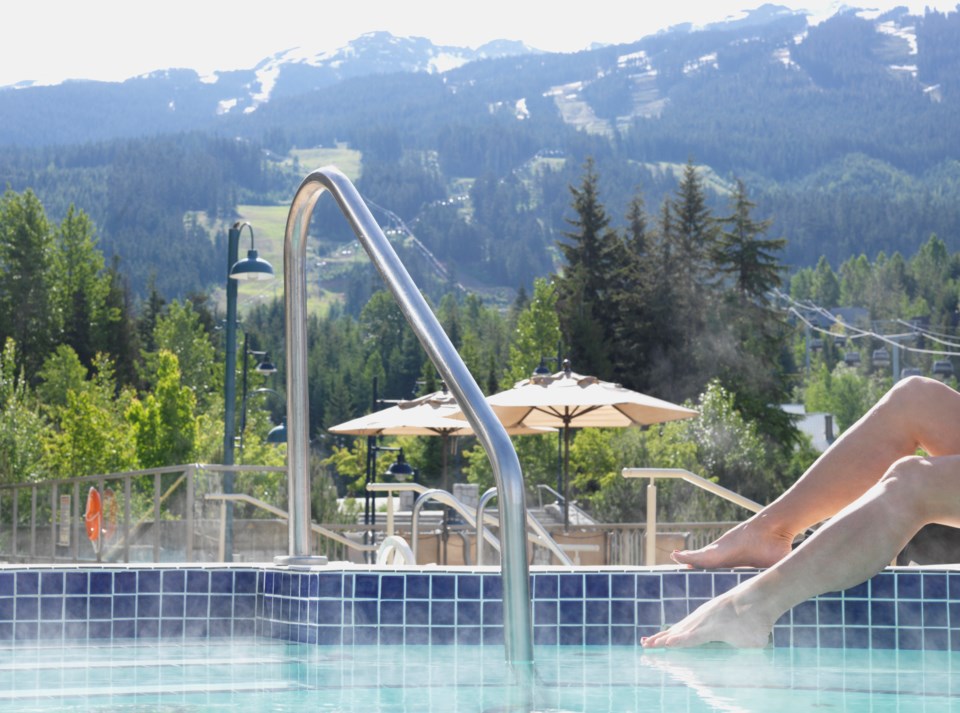Councillor Cathy Jewett still remembers when there was just a single heated, outdoor pool in Whistler.
“When my kids were growing up [in the ’80s], there was one pool in town in someone’s backyard, and that person gave swimming lessons. Now, I don’t even know how many pools there are, and I’d like to know.”
That was Jewett’s request at the Aug. 1 council meeting, when Resort Municipality of Whistler (RMOW) staff presented the findings from Whistler’s 2022 greenhouse gas inventory and climate action progress report. With the community still not on track to meet its long-stated target of slashing 2007-level carbon emissions in half by 2030, as well as its goal to cut residential building emissions by 20 per cent from 2007 levels in that same span, Jewett is looking to the outdoor heated pools and driveways she sees on her bike ride through Whistler’s luxury neighbourhoods as one potential means to pick up the slack.
“We talk about heating patios with those little lanterns. Heating an entire driveway that goes hundreds of metres, heating a pool that goes uncovered all winter, that’s just energy getting thrown into the atmosphere and being wasted, a lot of times in a place where nobody is there to enjoy it,” she said following the presentation.
Jewett was not without ideas to address the issue—although there remains some digging to be done to determine just how much authority the RMOW actually has to press the matter.
“Summer really only lasts three to four months, so what can we do to start creating a standard where it doesn’t put a strain on our resources, like our water supply?” she said in a follow-up interview. “That’s something we already started to deal with, with landscape and irrigation companies, so if we’re going to restrict irrigation, what are we doing in terms of pools? It’s one thing in the ’80s when there was one pool in town; now there are more.”
That’s why Jewett asked RMOW staff to return with an inventory of Whistler’s outdoor heated pools, something environmental stewardship manager Luisa Burhenne said she would look into through the building department.
Speaking with local pool technicians, however, at least relatively speaking, Whistler is no hotspot for outdoor pools.
“I’d say it’s less than five per cent of the households would even have them in town. We only service ... three of them in Whistler right now. All of them are down the corridor, further down in Squamish,” explained Derek Cote, GM and repair and maintenance engineer for The Splash Hot Tubs & Pools in Function Junction.
Poolside Spa Sales and Services owner Ken Nelson echoed that, estimating his Function-based company services only a handful of heated pools a year. He said a generous, community-wide estimate might put the number of heated pools as high as 100, but added they also tend to be a fraction of the size of the pools in other nearby communities without the same cap Whistler has on developable space—even in Whistler’s tony Kadenwood and Stonebridge neighbourhoods.
“You’re not talking your typical 100,000- litre pools. You may have a pool that has maybe 5,000 litres,” he said. “It’s not the same as Vancouver where the average house may have a 500,000-litre pool, and in a luxury home, it could be even 700,000, 800,000 litres. It’s very different.”
What’s more is, because of stringent provincial energy guidelines for new builds, and general environmental consciousness in the resort, even luxury homeowners are cognizant of their carbon output—and they’re willing to pay a premium for a higher- efficiency standard, said Tim Regan of local developer Vision Pacific.
“I think it’s a bit of a misnomer to just see the negative. I think a lot of people are spending a lot of time and effort on creating innovative, creative solutions, and I think that has to be celebrated,” he said.
Regan pointed to the $32-million Stonebridge mansion that sold last month in a record-setting deal, which featured an 82-foot-long cantilevered swimming pool that includes a cistern for rainwater and is heated through geothermal energy, a rarity in Whistler and beyond, with natural gas by far the most common method to heat pools.
Regan said you also have to keep things in context: energy standards are so high thanks to both provincial and municipal legislation that new builds are already far more efficient energy-wise than their older counterparts.
“The last pool we did, it’s fully insulated and it’s almost like a garage door that goes over top of it,” he said. “It’s more expensive to do it this way, but they are massively higher performing, and the carbon footprint is less because of the efficiency of how it’s fuelled and heated.”
Along with getting an inventory of Whistler’s pools, Jewett suggested the RMOW require newly built pools to not utilize natural gas as a heating source, along with having homeowners install a water meter to ensure “potable water gets used for potable things,” she said.
“The permitting system is, I think, the only way we have leverage. You don’t get a building permit if you’re going to put in a driveway that’s heated with natural gas or a pool that is using potable water from our purification systems and heated with natural gas,” Jewett added.
“I just see these bigger and bigger part- time residences built with these amenities that put a stress on our resources.”
Heated driveways are far more likely to be the bigger contributor to energy use; Cote said the amperage alone to heat them would require exponentially higher energy than what it would take to heat the average outdoor pool.




